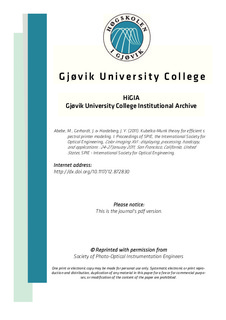| dc.contributor.author | Abebe, Mekides | |
| dc.contributor.author | Gerhardt, Jérémie | |
| dc.contributor.author | Hardeberg, Jon Yngve | |
| dc.date.accessioned | 2011-04-15T09:27:34Z | |
| dc.date.available | 2011-04-15T09:27:34Z | |
| dc.date.issued | 2011 | |
| dc.identifier.citation | Abebe, M., Gerhardt, J. & Hardeberg, J. Y. (2011). Kubelka-Munk theory for efficient spectral printer modeling. I: Proceedings of SPIE, the International Society for Optical Engineering, Color imaging XVI : displaying, processing, hardcopy, and applications : 24-27 January 2011, San Francisco, California, United States, SPIE - International Society for Optical Engineering. | en_US |
| dc.identifier.isbn | 9780819484031 | en_US |
| dc.identifier.issn | 0277-786X | |
| dc.identifier.uri | http://hdl.handle.net/11250/142512 | |
| dc.description | This is the copy of journal's version originally published in Proc. SPIE 7866: http://spie.org/x10.xml?WT.svl=tn7. Reprinted with permission of SPIE. | en_US |
| dc.description.abstract | In the context of spectral color image reproduction by multi-channel inkjet printing a key challenge is to accurately model the colorimetric and spectral behavior of the printer. A common approach for this modeling is to assume that the resulting spectral reflectance of a certain ink combination can be modeled as a convex combination of the so-called Neugebauer Primaries (NPs); this is known as the Neugebauer Model. Several extensions of this model exist, such as the Yule-Nielsen Modified Spectral Neugebauer (YNSN) model. However, as the number of primaries increases, the number of NPs increases exponentially; this poses a practical problem for multi-channel spectral reproduction. In this work, the well known Kubelka-Munk theory is used to estimate the spectral reflectances of the Neugebauer Primaries instead of printing and measuring them, and subsequently we use these estimated NPs as the basis of our printer modeling. We have evaluated this approach experimentally on several different paper types and on the HP Deskjet 1220C CMYK inkjet printer and the Xerox Phaser 7760 CMYK laser printer, using both the conventional spectral Neugebauer model and the YNSN model. We have also investigated a hybrid model with mixed NPs, half measured and half estimated. Using this approach we find that we achieve not only cheap and less time consuming model establishment, but also, somewhat unexpectedly, improved model precision over the models using the real measurements of the NPs. | en_US |
| dc.language.iso | eng | en_US |
| dc.publisher | Society of Photo Optical Instrumentation Engineers (SPIE) | en_US |
| dc.relation.ispartofseries | Proceedings of SPIE;7866 | |
| dc.title | Kubelka-Munk theory for efficient spectral printer modeling | en_US |
| dc.type | Journal article | en_US |
| dc.type | Peer reviewed | en_US |
| dc.subject.nsi | VDP::Mathematics and natural science: 400::Information and communication science: 420::Simulation, visualization, signal processing, image processing: 429 | en_US |
| dc.source.pagenumber | 15 | en_US |
| dc.identifier.doi | http://dx.doi.org/10.1117/12.872830 | en_US |
